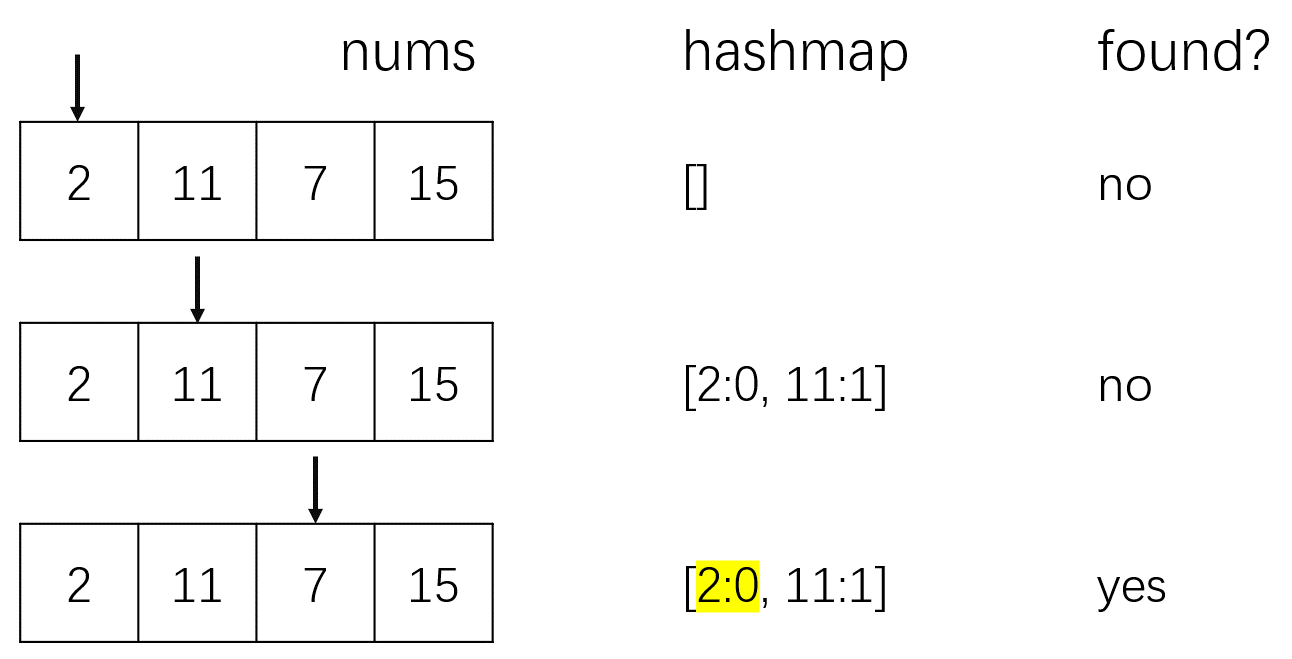目录
1 基础知识
1.1 定义哈希表
1.2 遍历哈希表
1.3 查找某一个键
1.4 插入键值对
1.5 获取键值对的值
1.6 搜索功能
2 三道题
2.1 1. 两数之和
2.2 49. 字母异位词分组
2.3 128. 最长连续序列
菜鸟做题第一周,语言是 C++
1 基础知识
1.1 定义哈希表
unordered_map<string, vector<string>> hashtable;- unordered_map 用于定义哈希表
- 第一个参数为 key 的数据类型,这里是 string 类型
- 第二个参数为 value 的数据类型,这里是 vector<string> 类型
1.2 遍历哈希表
for (auto str:hashtable) {// code
}- 这种遍历方法对其他容器也适用
- 冒号后写遍历的对象,这里是 hashtable
- 冒号前写被遍历到的元素,这里取名为 str
1.3 查找某一个键
auto it = hashtable.find(target);
if (it != hashtable.end()) {// code
}- find() 的参数是想要查找的 key
- it 是本次查找的结果
- 若没有找到,则 it 等于 hashtable.end()
- hashtable.end() 是哈希表最后一个元素的后一位
1.4 插入键值对
// 方法一
hashtable[key] = value;
// 方法二
hashtable[key].push_back(value);- 目前看到过上述两种方法
- key 处填写键,value 处填写值
这是看人下碟,暂时还不太懂
1.5 获取键值对的值
// 方法一
str->second
// 方法二
str.second- 同样看到过两种方法
- str 是哈希表中的某一键值对
- second 代表想要获取的是 value
1.6 搜索功能
作用:搜索某个键是否存在于哈希表内。
hashtable.count(key)- count 的作用是搜索而不是计数
- key 代表想要搜索的键
- 若存在该键,则返回值为 1
2 三道题
2.1 1. 两数之和
解题思路:
- 遍历数字集合 nums
- 查询是否有和为 target 的另一个数字
思路说明图:
- 这里假设 target=9
- 将暂时没找到伴儿的数字放入哈希表中

class Solution {
public:vector<int> twoSum(vector<int>& nums, int target) {unordered_map<int, int> hashmap;for (int i = 0; i < nums.size(); ++i) {auto it = hashmap.find(target - nums[i]);if (it != hashmap.end()) {return {i, it->second};}hashmap[nums[i]] = i;}return {};}
};可能出现的问题:

虽然题设表明一定能找到一对和为 target 的数字,但力扣比较严谨,它要求 if 判断结构中的 else 情况也要进行返回(虽然用不到)。
2.2 49. 字母异位词分组
解题思路:
- 遍历 strs 中的每一个字符串
- 使用 sort 函数对这些字符串进行重新排序
- 排序前的字符串作为 key,排序后的字符串作为 value,插入到哈希表中
- 哈希表中每个键值对的 value 的集合即为最终的结果
class Solution {
public:vector<vector<string>> groupAnagrams(vector<string>& strs) {vector<vector<string>> result;unordered_map<string, vector<string>> hashtable;for (auto str:strs) {auto temp = str;sort(temp.begin(), temp.end());hashtable[temp].push_back(str);}for (auto str:hashtable) {result.push_back(str.second);}return result;}
};
这个涉及到哈希表的原理,即 key 相同时,如何存储不同的 value,暂时还没看
2.3 128. 最长连续序列
解题思路:
- 遍历 nums 寻找可能成为序列头的数字(不能存在 num - 1)
- 若找到可能成为序列头的数字,则顺着它找序列并计数(哈希表找 num + 1)
- 每计数完一条序列的长度都要和之前序列的长度进行比较(cucount 和 count)
- 返回最长的长度(count)
思路说明图:

思考过程:
一开始想的是找序列中最小的那个数字(我理所应当地认为它就是序列头),然后以它为开头去找序列并计数,但 nums 中可能存在不止一条连续序列,因此我们需要考虑所有可能的序列头。
class Solution {
public:int longestConsecutive(vector<int>& nums) {if (nums.size() == 0) return 0;int count = 1;unordered_map<int, int> hashmap;for (int i = 0; i < nums.size(); ++i) {hashmap[nums[i]] = i;}for (auto num:nums) {auto it = hashmap.find(num - 1);if (it == hashmap.end()) {int cucount = 1;it = hashmap.find(num + cucount);while (it != hashmap.end()) {++cucount;it = hashmap.find(num + cucount);}count = max(count, cucount);}}return count;}
};哈希表并不是最优解,因为貌似用不到 value,但我目前只会哈希表。。。

)


 主从复制)



)


自定义属性绘制器(PropertyDrawer ,PropertyAttribute) (全面总结 | 建议收藏))

)





